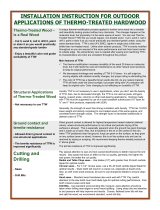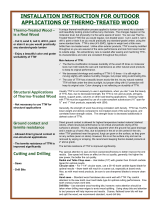
WARNING: If the information in these instructions is
not followed exactly, a fire or explosion may result
causing property damage, personal injury, or death.
WHAT TO DO IF YOU SMELL GAS
Do not try to light any appliance.
x Do not touch any electrical switch; do not use any
phone in your building.
x Immediately call your gas supplier from a neighbor's phone.
Follow the gas supplier's instructions.
x If you cannot reach your gas supplier, call the fire
department.
Installation and service must be performed by a qualified
installer, service agency or the gas supplier.
FOR YOUR SAFETY
Do not store or use gasoline or other flammable,
combustible, or corrosive vapors and liquids in the
vicinity of this or any other appliance.
CAUTION
Incorrect operation of this appliance may
create a hazard to life and property and
will nullify the warranty.
DANGER
Do not store or use gasoline or other
flammable, combustible, or corrosive
vapors and liquids in the vicinity of this
or any other appliance.
IMPORTANT
Before proceeding, please inspect the
water heater and its components for
possible damage. DO NOT install any
water heater with damaged components.
If damage is evident then please contact
the supplie
r where the water heater was
purchased or the manufacturer listed on
the rating plate for replacement parts.
WARNING
Water heaters are heat producing appliances. To avoid
damage or injury, do not store materials against the
water heater or vent-air intake system. Use proper care
to avoid unnecessary contac
t (especially by children) with
the water heater and vent-air intake components.
UNDER NO CIRCUMSTANCES MUST FLAMMABLE
MATERIALS, SUCH AS GASOLINE OR PAINT THINNER BE
USED OR STORED IN THE VICINITY OF THIS WATER
HEATER, VENT-AIR INTAKE SYSTEM OR IN ANY
LOCATION FROM WHICH FUMES COULD REACH THE
WATER HEATER OR VENT-AIR INTAKE SYSTEM.
WARNING
DO NOT ATTEMPT TO LIGHT ANY GAS APPLIANCE IF YOU
ARE NOT CERTAIN OF THE FOLLOWING:
x Liquefied petroleum gases/propane gas and natural gas
have an odorant added by the gas supplier that aids in
the detection of the gas.
x Most people recognize this odor as a “sulfur” or “rotten
egg” smell.
x Other conditions, such as “odorant fade” can cause the
odorant to diminish in intensity, or ”fade”, and not be
as readily detectable.
x If you have a diminished sense of smell, or are in any
way unsure of the presence of gas, immediately contact
your gas supplier from a neighbor's telephone.
Gas detectors are available. Contact your gas supplier, or
plumbing professional, for more information.
CAUTION
If sweat fittings are to be used DO NOT apply heat to the
nipples on top of the water heater. Sweat the tubing to
the adapter before fitting the adapter to the water
connections. It is imperative that heat is not appli
ed to
the nipples containing a plastic liner.
WARNING
FAILURE TO INSTALL AND MAINTAIN A NEW, LISTED 3/4” X
3/4” TEMPERATURE AND PRESSURE RELIEF VALVE WILL
RELEASE THE MANUFACTURER FROM ANY CLAIM THAT
MIGHT RESULT FROM EXCESSIVE TEMPERATURE AND
PRESSURES.
WARNING
Hydrogen gas can be produced in an operating water
heater that has not had water drawn from the tank for a
long period of time (generally two weeks or more).
Hydrogen gas is extr
emely flammable. To prevent the
possibility of injury under these conditions, we
recommend the hot water faucet to be open for several
minutes at the kitchen sink before you use any electrical
app
liance which is connected to the hot water system. If
hydrogen is present, there will be an unusual sound such
as air escaping through the pipes as hot water begins to
flow. Do not sm
oke or have open flame near the faucet
at the time it is open.
CAUTION
Turn off or disconnect the electrical power supply to the
water heater before servicing. Label all wires prior to
disconnection when servicing controls. Wiring errors can
cause improper and d
angerous operation. Verify proper
operation after servicing.
Page 3





















